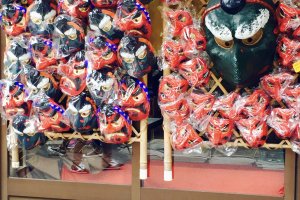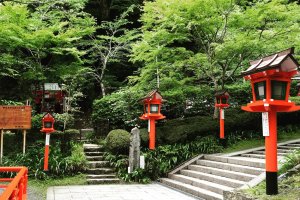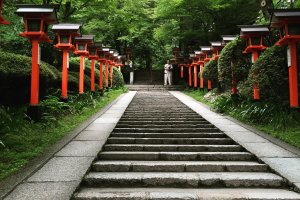Nestled in the mountainside of northern Kyoto prefecture, 鞍馬 (Kurama) and 貴船 (Kibune) feel like an entire world away from the busy metropolis of the nearby city. At only 40 minutes north of Kyoto and 90 minutes from Osaka, it’s no wonder these tiny villages have been locally known for centuries to provide peace and tranquility to any who visit.
While you can start at either town, on this occasion I began at Kurama station (鞍馬駅), the last stop on the Eizan Railway line from Demachi Yanagi Station (出町柳).
Coming out from the station the first thing you’ll see are the Tengu (天狗) statues; the mischievous mountain goblins with supernatural powers and supreme fighting skills who are believed to live on Kurama mountain.
Leaving the station, there is a path which leads up to Kurama Temple (鞍馬寺), a centuries old Buddhist retreat. A cable car can take you to the top for ¥100, or you can walk about 30-40 minutes to reach the summit.
I personally recommend walking; the path winds through the forest and passes by Yuki Jinja (由岐神社), a small Shinto shrine which hosts the annual Kurama Fire Festival on October 22.
The main pavilion of Kurama Temple was founded in 770 by a disciple of the Chinese monk Jianzhen and is believed to be a great source of spiritual energy. During the full moon in May the temple holds the Wesak Festival, arguably the most important Buddhist festival of the year.
Behind the main temple begins the path towards Kibune, the next village on the mountain. You can also take a short detour across the ridge to Osugi Gongen (大杉大杉権現), a quiet shrine in a grove of trees believed to be the birthplace of Reiki. It is here that Mikao Usui meditated for 21 days, near a great tree that is thought to be the reincarnation of the god Mao-son.
Winding through the forest will take you to Kibune Shrine (貴船神社). According to legend, Kibune was found by a goddess travelling in a yellow boat (hence the kanji: ki (貴) yellow, and bune/fune (船) boat). It is believed that this boat is buried at Okunomiya (奥宮), the inner sanctum of Kibune shrine.
Following the path down to the town, the streets are lined with traditional ryokan and restaurants. Between June and September, visitors can enjoy a meal on platforms built over the river (川床 – kawadoko). Most restaurants range in price from ¥3000 -¥20,000 per person for the experience.
At night time, the whole area is lit up by lanterns, giving travellers an even greater sense of solitude and peace. Most tourists leave before dinner time, so the area can be quite secluded around dusk.
Access
Kibune (Kibune-Guchi 貴船口駅) and Kurama (Kurama Station 鞍馬駅) are located on the Eizan Railway from Demachi Yanagi Station (出町柳駅).
From Kyoto Station, take the JR Nara Line to Tofukuji Station (東福寺駅) (2 minutes,¥140 one way) and transfer to the Keihan Main Line for Demachi Yanagi Station (出町柳駅) (10 minutes,¥270 one way).
From here, Kibune-Guchi (貴船口駅) is 27 minutes away (¥420 one way) and Kurama Station (鞍馬駅) is 30 minutes away (¥420 one way).
Kurama Temple is open all year long from 9am-4:30pm (9am-5pm Jun-Aug)



































